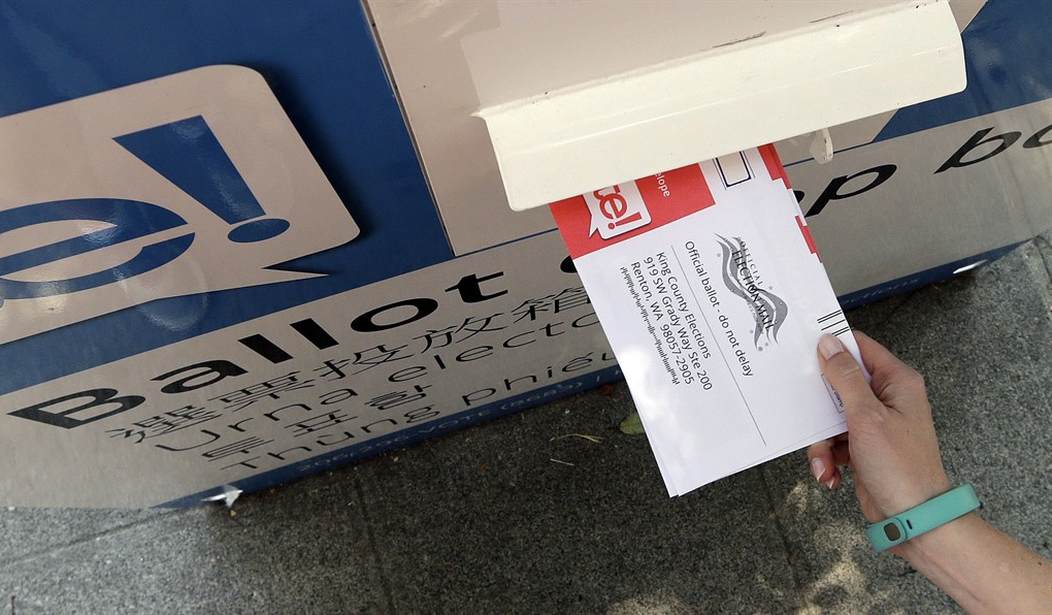This article is the 11th installment of the VICI Report, a comprehensive multi-part series exploring the sophisticated use of technology in political operations. This series aims to uncover the processes, mechanisms, tools, and technologies used by Democrats to master our political processes and to develop strategies which answer and ultimately defeat their manipulations in 2024 and beyond.
Read the previous article in this series, Compromised Before Voting Begins, which systematically analyzes ballot harvesting from tabulation back through the voting, or start from the beginning of our series.
Introduction
While securing the tabulation phase and the voting process is crucial, the integrity of elections also heavily depends on the handling of ballots and the voter registration process. These stages present numerous opportunities for manipulation, making them critical points of focus for ensuring fair and transparent elections. The handling of mail-in/drop-off ballots, from the request to the verification stage, exposes the system to risks such as fraudulent ballot requests, data errors leading to duplicate or invalid ballots, and unauthorized handling. These vulnerabilities undermine the entire electoral process and erode public trust.
Moreover, the strategic use of real-time tracking systems like ERIC and the involvement of non-profits in voter registration further complicate the landscape. These tools and tactics provide significant advantages to those who can leverage them, highlighting the necessity for advanced technological measures and stringent oversight. By examining the phases of ballot handling and voter registration in detail, it becomes clear how systematic efforts can influence election outcomes. This scrutiny emphasizes the need for robust verification processes, enhanced data accuracy, and secure handling procedures to safeguard electoral integrity. Addressing these challenges is essential for protecting the sanctity of the vote and ensuring the fairness and transparency of future elections.
Receiving the Ballot
The balloting phase is a crucial step in the electoral process, encompassing the sequence of the Ballot Request, Voter Confirmation, and Ballot Provision to the Voter. This phase is supposed to ensure that only eligible voters receive ballots, highlighting the importance of a thorough verification process to prevent errors and fraud.
In-person ballot requests involve a straightforward and secure process. Voters request a ballot from a poll worker who verifies their identity and eligibility on the spot, including, depending upon the state, checking an official identification card or driver’s license. This immediate oversight should ensure that only verified individuals receive ballots, theoretically maintaining a secure chain-of-custody and minimizing the risk of errors.
In contrast, the mail-in/drop-off (MIDO) process introduces several potential issues. Ballots can be requested by mail, online, or automatically triggered by a government database. This system lacks the immediate verification seen in in-person voting. The lack of direct oversight increases the risk of fraudulent ballot requests and unauthorized handling.
The potential for manipulation in both in-person and MIDO processes is significant. In-person voting benefits from secure chain-of-custody and immediate verification, reducing opportunities for tampering. However, MIDO ballots face multiple risks: fraudulent ballot requests, data errors, and system overloads from large quantities of distributed ballots. These issues can lead to the distribution or receipt of invalid ballots, undermining the integrity of the electoral process.
Manipulation points in MIDO processes are particularly concerning. Fraudulent ballots can be generated due to data errors or false data, resulting in duplicate ballots, ballots sent to deceased individuals, or ballots sent to outdated addresses. These seemingly innocuous errors can hide fraudulent activity, especially if done at scale. Physical manipulation, interception, or error during mail transit further increases the risk of tampering. Additionally, the sheer volume of ballots can overwhelm tracking systems, making it difficult to ensure every ballot's integrity.
Another significant risk is the strategic targeting of ballot requests to favorable demographics or precincts. Democrats have leveraged the ERIC system and state data feeds to gain real-time access to ballot information, allowing them to track whether ballots have been received, cast, and returned.
This data advantage provides an unprecedented capability to influence election outcomes by focusing efforts on aligned non-voters and ensuring these ballots are cast and counted. Republicans, lacking similar access and real-time processing capabilities, are at a strategic disadvantage.
Past elections provide clear examples of these vulnerabilities. In 2020, Matt Braynard's analysis, now scrubbed from search engines, identified potential large-scale fraud through statistical and data irregularities as well as mismatches in voter information. His findings demonstrated how errors in data management could be exploited to introduce fraudulent activity at scale.
The ability to track individual ballots and their status within the system, from receipt to return and tabulation, has revolutionized vote management. This capability, integrated into Democratic vote management apps and platforms, provided an unprecedented advantage in 2020.
Ensuring the security and integrity of the balloting phase requires a comprehensive approach. Implementing stringent verification processes for mail and online ballot requests is essential. Enhancing data accuracy and maintaining secure methods for ballot provision are critical steps. Furthermore, leveraging technology to improve tracking and transparency can help mitigate risks associated with the MIDO process.
Addressing these vulnerabilities is fundamental to safeguarding the electoral process. Robust oversight, accurate data management, and secure handling procedures are necessary to prevent exploitation and maintain voter confidence in the electoral system.
Registration Relationship
The voter registration process is foundational to the electoral system, involving several key steps: a Change/Registration Form is presented to the voter, the voter fills out the form, the form is submitted to authorities, the voter’s personal information is processed, the voter database is updated, and a confirmation or identifier is sent to the voter. This process theoretically ensures that only eligible voters are registered and that their information is accurately recorded.
Different methods of voter registration introduce various dynamics and potential issues. Motor-voter laws allow individuals to register when they apply for or renew their driver's licenses, offering convenience but also the potential for data errors if DMV records are not updated accurately. Automatic registration, implemented in some states, enrolls voters using information from other government databases, which can streamline the process but may also introduce errors if the data is not properly vetted.
Government office registrations involve voters filling out forms at designated locations, often a county or township clerk’s office, ensuring immediate verification but possibly deterring those who cannot easily visit these offices. Online registration offers convenience and accessibility but increases the risk of data breaches and fraudulent registrations. Volunteer voter drives, often conducted by non-profits, can boost registration numbers significantly but also pose risks if not properly monitored, as volunteers might unintentionally introduce errors or intentionally proffer fraudulent registrations.
Potential manipulation points in the registration process are significant. Fraudulent ballots can be generated due to data errors or false data, resulting in duplicate ballots, ballots sent to deceased individuals, or ballots sent to outdated addresses. These seemingly innocuous errors can hide fraudulent activity, especially if done at scale. Physical manipulation, interception, or errors during the submission process further increase the risk of tampering. Additionally, the sheer volume of registration forms can overwhelm tracking systems, making it difficult to ensure the integrity of voter data.
Another significant risk is the strategic targeting of voter registrations to favorable demographics or precincts. Democrats have leveraged the ERIC system to gain real-time access to voter information, allowing them to strategically focus on specific areas. This data advantage provides an unprecedented capability to influence election outcomes by ensuring that targeted demographics are registered and ready to vote. Republicans, lacking similar access and real-time processing capabilities, are at a further strategic disadvantage.
The use of non-profits to register voters has often bypassed fundraising rules, with many of these organizations being Democrat-aligned. This strategic use of non-profits has allowed for mass registration efforts that may not always adhere to strict regulatory standards.
A current concern involves the use of the HAVA (Help America Vote Act) database, managed by the Social Security Administration, to verify new voter registrations. News reports by Tim Pool of Timcast and others indicate that unknown actors in states like Texas and Missouri are attempting to register tens to hundreds of thousands of new voters each week, with many thousands to tens of thousands rejected, indicating these individuals are deceased.
This anomaly suggests a potential organized effort to register large numbers of illegal migrants, particularly in states experiencing high immigration flows. The scale and consistency of these errors highlight the vulnerability of the registration process to systematic manipulation.
Scott Presler’s efforts demonstrate the potential for positive manipulation in the registration process. His "Johnny Appleseed" approach to registering Republican voters shows how strategic, grassroots efforts can boost voter registration numbers effectively and ethically. Presler's important work illustrates that Republicans can also leverage systematic registration efforts to their advantage, countering the notion that Democrats have a monopoly on such tactics.
Ensuring the security and integrity of the registration process requires addressing these vulnerabilities comprehensively. Implementing stringent verification processes, enhancing data accuracy, and maintaining secure methods for registration are essential steps. Furthermore, leveraging technology to improve tracking and transparency can help mitigate risks associated with the registration process.
Addressing these vulnerabilities is fundamental to safeguarding the electoral process. Robust oversight, accurate data management, and secure handling procedures are necessary to prevent exploitation and maintain voter confidence in the electoral system.
Conclusion
The integrity of the electoral process extends beyond the act of voting to encompass the critical phases of ballot handling and voter registration. Vulnerabilities identified in the receiving and verification of ballots highlight significant manipulation risks. Fraudulent ballot requests, data errors, and unauthorized handling can undermine the electoral system's integrity, allowing for systematic exploitation. The strategic use of real-time tracking systems like ERIC and targeted non-profit involvement in voter registration adds complexity, revealing how manipulations can occur on a large scale.
Addressing these vulnerabilities requires stringent verification processes, robust oversight, and the leveraging of technology to enhance transparency and security. Ensuring data accuracy and maintaining secure methods for ballot provision are critical steps in safeguarding the electoral process. The examples from past elections underscore the need for comprehensive strategies that can adapt to evolving tactics used to influence election outcomes.
Understanding these challenges sets the stage for a deeper examination of the sophisticated strategies employed by Democrat operations to manipulate electoral processes. The next exploration will delve into how these strategies impact public trust and the overarching integrity of the democratic system. By analyzing the advanced techniques used to influence elections, we can develop more effective measures to counteract these tactics and restore confidence in the electoral process. This comprehensive approach is essential for protecting the sanctity of the vote and ensuring the fairness and transparency of future elections. The commitment to addressing these issues is crucial for maintaining a robust and trustworthy republican form of government.
Sinistra Delenda Est!
In the next installment of the VICI Report series, we continue our anatomy of a ballot harvest, recapping the process with a warning for how technology plays the crucial role in the manipulation of our elections.
The VICI Report and Project VICI are projects of UpHold America, led by Paul Porter (X:@PaulPorterPVB) and Jason Belich (X:@BelichJason).
The VICI Report series is a culmination of many months of sleepless nights; the product of exhaustive research and analysis into the technologies used in politics by a Democrat adversary excessively skilled at manipulating political outcomes. Your support is critical to the success of this mission. Please visit our website, support our GiveSendGo, or join our Substack to contribute.














Join the conversation as a VIP Member